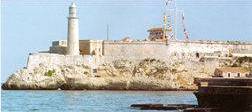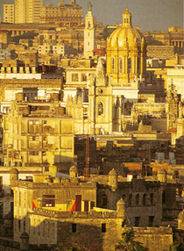TO CUBA
WITH
USA CUBA

|
TO CUBA WITH USA CUBA |
 |
| Welcome
About us Travel tips SPECIALTIES
BUSINESS
PRODUCTS
FEEDBACK
ABOUT CUBA
TRAVEL INDUSTRY
NOTICE
FOR
|
 Old
City of Havana Old
City of Havana
Regions of Cuba - Travel Guide San Cristobal de La Habana Villa was founded in 1519 and shortly afterward became the capital of the island. For centuries it was a strategic center of colonial Spain. Owing to its characteristics as a port city and its unique geographical location at the mouth of the Gulf of Mexico, Havana quickly took on a predominant positionas a trade and communications link between the Old and the New Worlds, while, at the same time, receiving the title of "Key to the Gulf". The city became a desirable prize, targeted by corsairs and pirates who attacked it on countless occasions, forcing the metropolis to build  a
defense system which was unique in America, and to construct a surrounding
wall. a
defense system which was unique in America, and to construct a surrounding
wall.
Old Havana still houses vestiges of its origins, such as the Alameda de Paula, next to the port, the Plaza de Armas and Cathedral Square, the Castillo de la Real Fuerza and the Morro and La Cabana castles, the Palacio de los Capitanes Generales, the Palacio del Segundo Cabo, as well as the ruins of the walls that once surrounded it and the brick streets that have defied time in order to reveal all the greatness of the past. At the end of 18th century, Havana began to expand beyond its tight limits and Havana-outside-the-walls was born. With the demolition of the wall in 1863, a process of urbanization was underway and the city experienced growth in every sense of the term. In 1902, after the U.S. intervention and the establishing of the Republic, the old part of Havana entered a period of decadence even though it still contained buildings of genuine architectural value.
Havana's Historical Office has developed
a project to preserve the historic city center while maintaining the social
and cultural environment of the Old City. Since
Traditions, legends and history have combined to make Old Havana a historical heritage jewel, renowned for its magnificent buildings, squares and churches, all of which date back to colonial times. City streets are still paved with cobblestones. Happy mestizo faces look down from balconies adorned with lush vegetation, re-enacting a scene that is centuries old. USA CUBA TRAVEL invites you to experience the elation of walking through a mystical city whose worth has been established over the centuries, to savor its culture, discover its people and relive history by staying in one of the fabulous historic hotels of Old Havana.
Updated August
20, 2000
Copyright ©2000 USA CUBA TRAVEL |